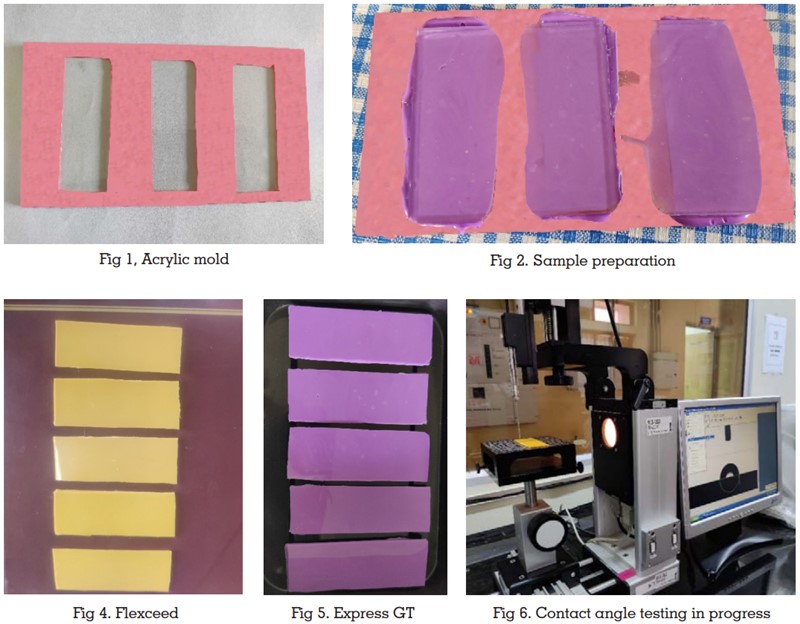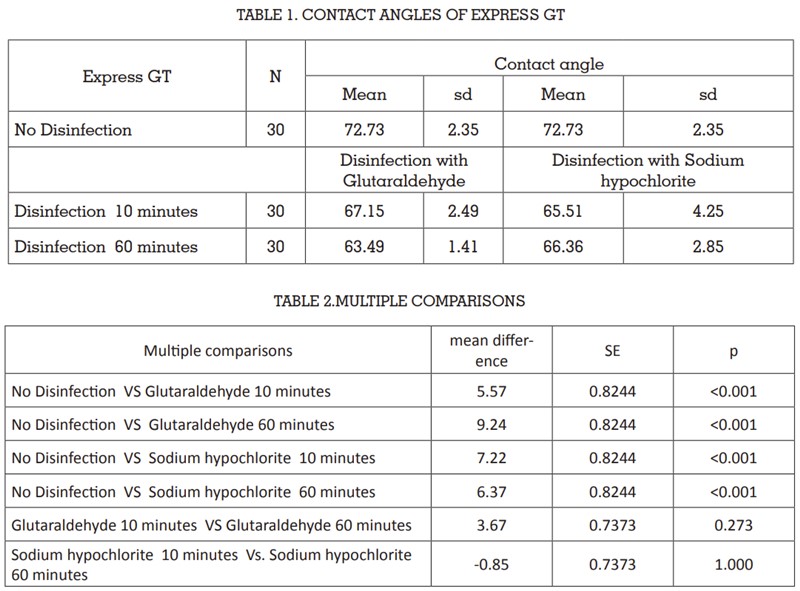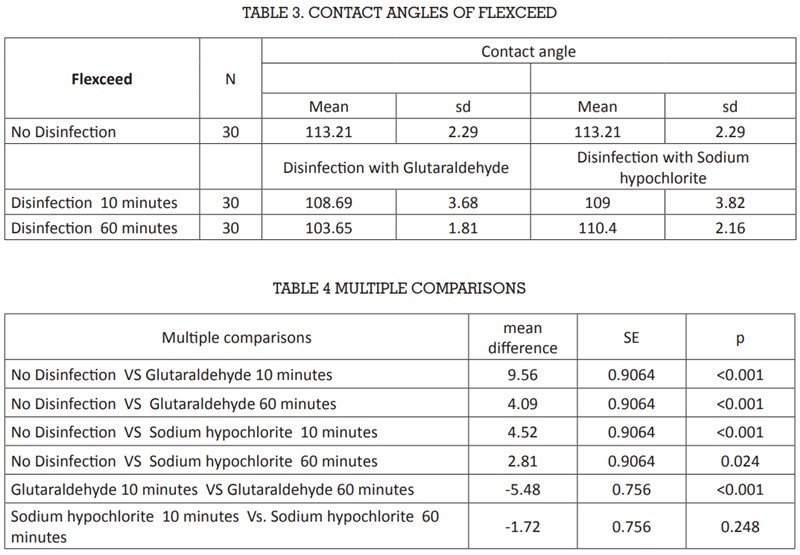

Introduction: This study aims to evaluate the surface
wettability of addition silicone impression materials,
which were treated with two different disinfecting
agents for two different time intervals.
Methods: Twenty-five rectangle-shaped specimens
from each of two different addition silicone
impression materials (Express GT and Flexceed)
were prepared. Five samples from each impression
material were kept as the control without any
disinfection. The rest of the specimens were divided
into two groups according to the disinfecting agents,
(2% Glutaraldehyde and 0.5% sodium hypochlorite)
and disinfected for two time periods (10 minutes,
and 60 minutes). Later, surface wettability was
tested and recorded. Data were analyzed with
analysis of variance (ANOVA).
Results: The mean contact angle values of both
impression materials at 10 minutes of disinfection
were reduced when compared to the control group (without disinfection). As the disinfection time
increases there was a tendency of decreasing
the contact angle for Flexceed and Express GT
impression material for glutaraldehyde disinfectant.
But for Flexceed, the mean contact angle values
increased after 60 minutes of disinfection with
sodium hypochlorite.
Key words: Additional Silicone, Contact Angle, Disinfection, Wettability
Disinfection of dental impressions should be a
routine procedure in the dental office and dental
laboratory. Dental impressions are categorized
under semi-critical objects in dental practice and
require a high level/ intermediate level of disinfection or sterilization. The dental impressions are
usually contaminated with saliva, plaque, and
sometimes blood, all of which may carry pathogenic microorganisms. The impressions must be
disinfected thoroughly to prevent cross-infection, after removal from the patient’s mouth and prior
to cast preparation, as recommended by ADA1
.
Cross-infection control is of prime importance in
dental practice but impression disinfection is still
a widely neglected aspect2
. The proper criteria for
impression disinfection involve the most suitable
method (spray or immersion) and appropriate
application (time of contact). The factors to be
considered for any disinfection protocol for dental
impressions are the effectiveness, chemical stability, and efficacy of the disinfectant solution. The
disinfection procedure should not alter the dimensions and surface details of the resultant casts or
dies. It has been proven that the most effective
method of reducing the burden of microorganisms
from the impression surface is chemical disinfection. Spray disinfection and immersion disinfection
are the two methods of impression disinfection.
However, immersion is the most reliable method
because all surfaces of the impression and tray
come in contact with a disinfectant solution. But
immersion is not the method of choice for hydrophilic impression materials3
.
Vinyl Polysiloxane (VPS) impression materials are
widely used for obtaining dimensionally accurate
and stable models of oral structures, particularly
in the production of inlays, crowns, and bridges4
.
Not only are VPS impression materials highly
accurate and dimensionally stable, but they are
offered in a wide range of viscosities for many applications and are easy to sterilize without harming
the qualities of the material. Unfortunately, VPS
impression materials are inherently hydrophobic,
so they are susceptible to poor wetting of moist
oral tissues and aqueous slurries of gypsum-based
die materials (dental stone) resulting in casts
and dies with pits and voids. Newer hydrophilic
VPS impression materials have been developed
to provide improved impression-making. Some
manufacturers claim that the wettability of their
VPS impression materials has been increased
with the addition of new hydrophilic agents to the
formulation. However, few have studied the effect of various aqueous clinical disinfectants on the
wettability of low viscosity, hydrophilic impression
materials by dental stone slurries. The accuracy of
the impression is affected by any change in surface
reactivity as impressions are often treated with
disinfectant to limit the transmission of diseases
such as HIV and hepatitis B. Disinfecting dental
impressions may affect the surface wettability of
the impression material used4
.
The wettability of the impression material can be
evaluated by measuring the contact angle of a
liquid droplet (distilled water) on the solid surface
of the impression material. The contact angle is the
angle formed between the surface of the wetted
solid and a line tangent from the curved surface
of the drop. As the angle increases, the wettability
decreases. Low values indicate good wettability.
In this context, the present study is designed to
evaluate the effect of two commercially available
chemical disinfectants namely 2% Glutaraldehyde
and 0.5% sodium hypochlorite on the wettability of
addition silicone impression materials at different
exposure intervals of 10 minutes and 60 minutes.
It is an in vitro study conducted according to
the guidelines of the local ethical committee
of Govt Dental College, Thiruvananthapuram
(IEC/E/27/2020/GDCT/Dated 06-01-2021
Fifty specimens (75mm x 25 mm x 2mm) of two
addition silicone impression materials were fabricated using a rectangular acrylic mold (Fig.1). For
preparing the acrylic mold, self-cure acrylic was
mixed and placed on a glass slab and a 75mm x
25 mm x 2mm microscope slide was pressed on
it during the dough stage to create rectangular-shaped molds. The impression material was expressed onto the prepared mold using automatic
mixing and dispensing device (Generic Dental
Dentmax 3M) and a glass slab was pressed over
it till the material was set to get a smooth and
polished surface (Fig 2). Immediately after setting the specimens were retrieved and stored in airtight
containers. Then the specimens were divided into
two main groups as there were two impression
materials used for the study. (Express GT light body
(3M ESPE Dental Products U.S.A.) and Flexceed
light body (GC India Dental Pvt Ltd)).

The specimens obtained from each impression
material were randomly divided into five groups
with five specimens in each group according to
disinfectant type and duration of disinfection.
(Fig 3 & 4) Five specimens from each group were
set aside as control without any disinfection. The
disinfectants 2% glutaraldehyde and 0.5% Sodium
hypochlorite solution were studied for two exposure
times, 10 minutes and 60 minutes.
Five specimens from each group were subjected
to disinfection by spray method with 2% Glutaraldehyde (Cidex) and 0.5% Sodium hypochlorite
(Nice) solution at intervals of 10, and 60 minutes.
During the time of disinfection, specimens were
stored in closed containers to avoid evaporation of
disinfectant. Specimens were thoroughly washed
with distilled water for one min, air dried, then
stored again in closed containers. All specimens
were coded for identification.
Contact angle measurements of the surfaces of
all specimens were performed using a Dynamic
Contact Angle analyzer (Data physics Contact
Angle system). Each specimen was mounted on
the adjustable mechanical stage of the Goniometer. Using an installed needle, a drop of distilled
water was released on the surface of specimens at
room temperature. An optic device equipped with
a high digital video camera was used to monitor
the dropped water. Images were monitored until
the drop of distilled water contacted the surface
of the specimen (Fig. 5). The contact angle at six
different areas of each specimen was recorded
and expressed as mean ± standard deviation
(Tables 1 & 3)
The statistical analysis was performed using IBM
Statistical Package for Social Sciences (IBM-SPSS
ver. 24). Two-way repeated measures analysis of variance (ANOVA) test was used to compare contact angle measurements between the control, and
experimental groups at different time intervals.
A p-value of <0.05 is considered as statistically
significant.


The contact angle of impression material was reduced following disinfection with Glutaraldehyde
and sodium hypochlorite. When compared with the
control group (No disinfection) the mean contact
angle of Flexceed and Express GT decreased
significantly (p= <.001) after disinfection with
glutaraldehyde for time periods of 10 and 60 minutes. {TABLE 1). When compared with the control
group, the mean contact angle of Flexceed and Express GT decreased significantly (p= <.001)
after disinfection with sodium hypochlorite at time
intervals of 10 and 60 minutes. This demonstrates
that surface disinfection has no adverse effects
on the wettability of addition silicone impression
material.
While comparing the mean contact angle (MCA)
of Express GT and Flexceed impression material disinfected with glutaraldehyde and sodium
hypochlorite at two different exposure periods (10
& 60 minutes), the specimens disinfected for 60
minutes with glutaraldehyde showed a decrease
in contact angle values than those disinfected for
10 minutes and the values were statistically significant. But disinfection with sodium hypochlorite
exhibited an increase in contact angle even though
the values were not statistically significant.
The possibility of transmission of communicable
disease through dental impressions has been
debated by researchers in the last few decades5
.
Glutaraldehyde and sodium hypochlorite has been
recommended for dental impression disinfection
in several studies.
Addition silicone is considered to be the best dimensionally stable impression material, but the are inherently hydrophobic in nature. Usually, they
are made hydrophilic by adding surfactants by the
manufacturers. Surfactants (soap-like materials
that provide enhanced wetting of hydrophobic
surfaces by aqueous fluids) are added to some
impression materials to provide better wetting of
oral tissues and to enhance coverage with unset
stone, thus decreasing the occurrence of bubbles
in definitive casts.6
Exposure of the set impression
material to a liquid disinfectant may remove the
surfactant, rendering the impression surface more
hydrophobic and creating problems in obtaining
bubble-free definitive casts7
. The action of disinfectants on these surfactants is poorly studied. If
the wettability is not proper, the resultant casts
will be with lots of voids on their surfaces that can
affect the dimensional accuracy. Several studies have been conducted to assess the effect of
disinfectants on the surface wettability of dental
impression materials.
In the present study, the mean contact angle obtained for Express GT material was found to be in
the range of 650
-730
and for Flexceed, it was in the
range of 1000
to 1130
. A liquid is considered to be
wetting a surface when the contact angle is less
than 90 degrees and is considered non-wetting
when the contact angle is more than 90 degrees8
.
Thus an impression material is considered hydrophilic if the contact angle is less than 90 degrees.
Here we have not compared the contact values
between the two impression materials, but we
compared how the contact angle values were
affected by the two disinfectants with different
duration of disinfection.
Immersion disinfection is the most popular way
of disinfecting impressions, most likely because it
is guaranteed that all surfaces of the impression
and the tray will be contacted by the disinfectant.
It has been found that immersion disinfection can
alter impression materials by making them more
or less wettable. It is suggested that the surface
characteristics and chemical composition maybe affected during the disinfection procedure by
diluting or absorbing the surfactant present in the
impression material and by increasing the surface
roughness9
. Here we used spray disinfection in
order to prevent the disadvantages of immersion
disinfection.
In the present study, contact angle measurements
of impression materials (Express GT and Flexceed) disinfected with 2% glutaraldehyde and
0.5% sodium hypochlorite spray for 10 minutes
showed a significant reduction in contact angle
when compared with the control group (without
disinfection). This is in accordance with the study
conducted by Lad et al who concluded that a
10-minute spray disinfection of silicone and poly
ether impression using 2% Glutaraldehyde did
not compromise their wettability10.
The contact angle measurements of express GT
and Flexceed impression materials disinfected
with 2% glutaraldehyde at 10 minutes and 60
minutes had decreased contact angle values with
increasing exposure time. This result is in accordance with the study conducted by Al Zain in which
the contact angle measurements of impression
material subjected to disinfection were reduced
as the measuring time was prolonged11. When the
contact angle measurements of express GT and
Flexceed impression materials disinfected with
sodium hypochlorite at 10 minutes and 60 minutes
were compared, there is a tendency of increasing
the contact angle values with increasing exposure
time. Increasing the exposure time of disinfection
with sodium hypochlorite is not advantageous in
terms of wettability and it supports the disinfection
time of 10 minutes recommended by the manufacturers. This finding is commensurate with the
study of John Blalock et al, which showed that
the contact angle of a VPS surfactant containing
impression material will increase as the duration
of contact with a hypochlorite-based disinfectant
was increased12.
Many studies investigated the wettability of impression materials and the effects of different disinfection and surface treatments on the contact angle
of impression materials. Lepe et al concluded that
disinfecting low viscosity impression materials with
2% Glutaraldehyde for 30 minutes by the immersion method, exhibited a slight decrease in the
wettability of impression materials13. Blalock et
al used a hypochlorite-based disinfectant in their
study and concluded that the wettability of both
heavy and wash types of VPS impression materials decreased with increasing exposure times of
the disinfectant. Kang et al preferred quaternary
ammonium-based and chlorine based disinfectants for disinfecting VPS materials in their study
and stated that the chlorine-based disinfectant
was more advantageous in terms of wettability14.
Milward and Waters evaluated the effect of disinfection procedures on the wettability of VPS
impression materials and reported that short-term
disinfection by immersion significantly reduced
wettability15. Kotha et al evaluated five different
VPS materials in terms of chemical disinfection,
autoclave sterilization, and microwave sterilization, and concluded that all three methods did not
cause any significant difference in the wettability
of the impression materials16. Al Zain investigated
the wettability of VPS and polyether specimens,
disinfected with 0.5% glutaraldehyde spray. In
this study, impression materials disinfected with
0.5% glutaraldehyde were observed to have lower
contact angles at 0.5, 1, and 2- minute measurement points than not disinfected specimens, and
therefore 0.5% glutaraldehyde was recommended
to use for disinfecting the tested impression materials. Lad et al concluded that disinfecting silicone
and polyether impressions with 2% glutaraldehyde
by a 10-minute spray did not cause a significant
change in wettability.
The present study demonstrated that disinfection
performed with 2% glutaraldehyde increased the
wettability of two Vinyl polysiloxane impression
materials at two different time intervals of disinfection. But with Sodium hypochlorite, the wettability
decreased with increased disinfection time.
Silicone impression materials are available in
various consistencies. Only some of the low viscosity impression materials were evaluated in this
study. It is unreasonable to expect similar results
with various other brands of impression materials
with various consistencies subjected to different
immersion protocols with disinfectant solutions17.
The objective of this study was only to evaluate the
effect of disinfectant solutions on the wettability of
addition silicone impression materials. Factors like
dimensional changes and the effect of different
concentrations of various disinfectant solutions
on wettability were not investigated in the present
study. Further research can be undertaken in this
direction to overcome these limitations.
Within the limitations of the study, the following conclusions can be drawn